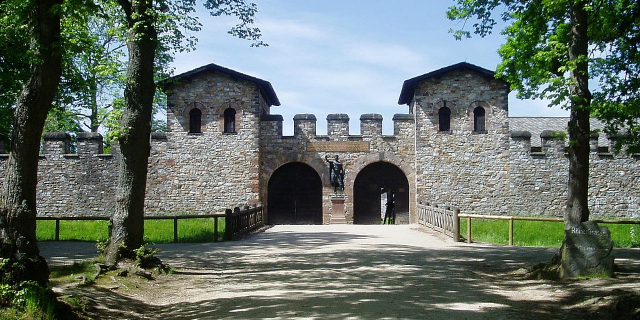Freudenberg (Siegerland)
( Freudenberg, Westphalia )Freudenberg is a town in the Siegen-Wittgenstein district, in North Rhine-Westphalia, Germany.
The town lies on the German-Dutch holiday road called the Orange Route, joining towns, cities and regions associated with the House of Orange.
The town of Freudenberg in its current form came into being through municipal reform on 1 January 1969. Into it the seventeen formerly self-standing municipalities of Alchen, Bottenberg, Bühl, Büschergrund, Dirlenbach, Freudenberg, Heisberg, Hohenhain, Lindenberg, Mausbach, Niederheuslingen, Niederholzklau, Niederndorf, Oberfischbach, Oberheuslingen, Oberholzklau and Plittershagen were merged into one.
The oldest constituent communities are most likely the two that were both mentioned in documents in the 11th century, namely Plittershagen and Oberholzklau in 1079. Freudenberg is known to have been an Amt and court seat as of the early 15th century. The village and the castle of Freudenberg had their first documentary mention in 1389.
The castle was founded over the Weibe Valley together with a settlement by the Counts of Nassau as a corner post of their domain. Count Johann IV of Nassau, Vianden and Diez gave the Freudenberg townsfolk their "freedom rights" on 7 November 1456. This was a kind of minimal town rights, but the document bestowing this distinction upon the town is taken as evidence of town rights being granted Freudenberg. Documents give clues that Freudenberg was established quite early on as a "Flecken", or market town. The historic town core is even still called Alter Flecken (alt means "old"; –er is a grammatical inflection).
In 1540, both the castle and the town were heavily damaged by a fire. On William the Rich's orders, there came into being about the mid 16th century new building works. The market town was given a new town wall with four gates. In the northwest, the Hohenhainer Tor was built, in the northeast the Weihertor, in the southeast the Braastor and in the southwest the Schultor (Tor means "gate"). However, owing to yet another town fire on 9 August 1666, the town was once again laid waste. Prince Johann Moritz von Nassau-Siegen built the town anew, using much the same layout, planned in 1540, as had stood before the fire. The castle, however, was not restored, and to this day, all that can be seen of it are a few wall remains.
In 1969, the new, greater Freudenberg came into being with the merger of the seventeen former municipalities named herein.


































Add new comment